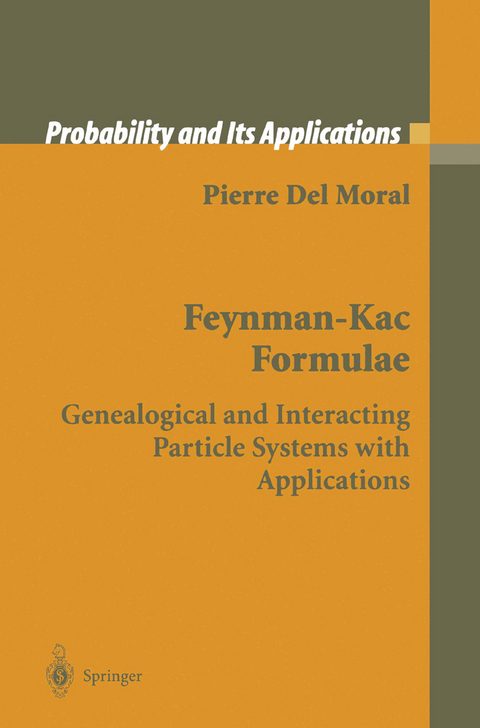
Feynman-Kac Formulae
Springer-Verlag New York Inc.
978-1-4419-1902-1 (ISBN)
1 Introduction.- 1.1 On the Origins of Feynman-Kac and Particle Models.- 1.2 Notation and Conventions.- 1.3 Feynman-Kac Path Models.- 1.4 Motivating Examples.- 1.5 Interacting Particle Systems.- 1.6 Sequential Monte Carlo Methodology.- 1.7 Particle Interpretations.- 1.8 A Contents Guide for the Reader.- 2 Feynman-Kac Formulae.- 2.1 Introduction.- 2.2 An Introduction to Markov Chains.- 2.4 Structural Stability Properties.- 2.5 Distribution Flows Models.- 2.6 Feynman-Kac Models in Random Media.- 2.7 Feynman-Kac Semigroups.- 3 Genealogical and Interacting Particle Models.- 3.1 Introduction.- 3.2 Interacting Particle Interpretations.- 3.3 Particle models with Degenerate Potential.- 3.4 Historical and Genealogical Tree Models.- 3.5 Particle Approximation Measures.- 4 Stability of Feynman-Kac Semigroups.- 4.1 Introduction.- 4.2 Contraction Properties of Markov Kernels.- 4.3 Contraction Properties of Feynman-Kac Semigroups.- 4.4 Updated Feynman-Kac Models.- 5 Invariant Measures and Related Topics.- 5.1 Introduction.- 5.2 Existence and Uniqueness.- 5.3 Invariant Measures and Feynman-Kac Modeling.- 5.4 Feynman-Kac and Metropolis-Hastings Models.- 5.5 Feynman-Kac-Metropolis Models.- 6 Annealing Properties.- 6.1 Introduction.- 6.2 Feynman-Kac-Metropolis Models.- 6.3 Feynman-Kac Trapping Models.- 7 Asymptotic Behavior.- 7.1 Introduction.- 7.2 Some Preliminaries.- 7.3 Inequalities for Independent Random Variables.- 7.4 Strong Law of Large Numbers.- 8 Propagation of Chaos.- 8.1 Introduction.- 8.2 Some Preliminaries.- 8.3 Outline of Results.- 8.4 Weak Propagation of Chaos.- 8.5 Relative Entropy Estimates.- 8.6 A Combinatorial Transport Equation.- 8.7 Asymptotic Properties of Boltzmann-Gibbs Distributions.- 8.8 Feynman-Kac Semigroups.- 9 Central Limit Theorems.- 9.1 Introduction.- 9.2Some Preliminaries.- 9.3 Some Local Fluctuation Results.- 9.4 Particle Density Profiles.- 9.5 A Berry-Esseen Type Theorem.- 9.6 A Donsker Type Theorem.- 9.7 Path-Space Models.- 9.8 Covariance Functions.- 10 Large-Deviation Principles.- 10.1 Introduction.- 10.2 Some Preliminary Results.- 10.3 Crámer’s Method.- 10.4 Laplace-Varadhan’s Integral Techniques.- 10.5 Dawson-Gärtner Projective Limits Techniques.- 10.6 Sanov’s Theorem.- 10.7 Path-Space and Interacting Particle Models.- 10.8 Particle Density Profile Models.- 11 Feynman-Kac and Interacting Particle Recipes.- 11.1 Introduction.- 11.2 Interacting Metropolis Models.- 11.3 An Overview of some General Principles.- 11.4 Descendant and Ancestral Genealogies.- 11.5 Conditional Explorations.- 11.6 State-Space Enlargements and Path-Particle Models.- 11.7 Conditional Excursion Particle Models.- 11.8 Branching Selection Variants.- 11.9 Exercises.- 12 Applications.- 12.1 Introduction.- 12.2 Random Excursion Models.- 12.3 Change of Reference Measures.- 12.4 Spectral Analysis of Feynman-Kac-Schrödinger Semigroups.- 12.5 Directed Polymers Simulation.- 12.6 Filtering/Smoothing and Path estimation.- References.
| Reihe/Serie | Probability and Its Applications |
|---|---|
| Zusatzinfo | 6 Illustrations, black and white; XVIII, 556 p. 6 illus. |
| Verlagsort | New York, NY |
| Sprache | englisch |
| Maße | 155 x 235 mm |
| Themenwelt | Mathematik / Informatik ► Informatik ► Theorie / Studium |
| Informatik ► Weitere Themen ► CAD-Programme | |
| Mathematik / Informatik ► Mathematik ► Angewandte Mathematik | |
| Mathematik / Informatik ► Mathematik ► Wahrscheinlichkeit / Kombinatorik | |
| Naturwissenschaften ► Physik / Astronomie ► Thermodynamik | |
| Wirtschaft ► Betriebswirtschaft / Management | |
| ISBN-10 | 1-4419-1902-3 / 1441919023 |
| ISBN-13 | 978-1-4419-1902-1 / 9781441919021 |
| Zustand | Neuware |
| Haben Sie eine Frage zum Produkt? |
aus dem Bereich


